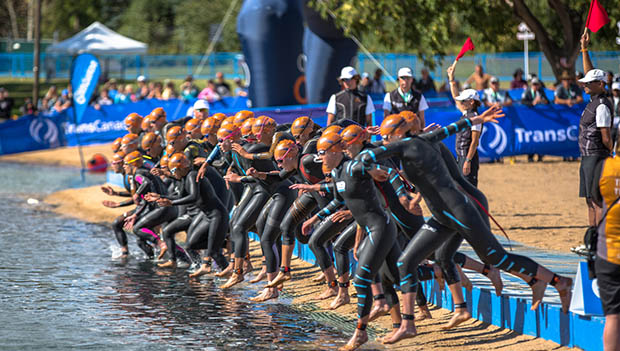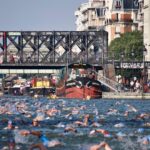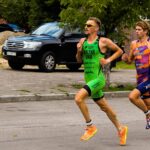In my second article in this three-part series in which I explore how intensity influences your triathlon efforts, I introduced you to how you can identify your “prime” (i.e., ideal) intensity. The value of knowing your prime intensity is that, before a race, you can monitor your intensity and evaluate whether your intensity, as the three bears might say if they were triathletes, too high, too low, or just right. This final article in my series shows you practical tools you can use, if you aren’t at prime intensity, to raise or lower it so you can swim, bike, and run your fastest.
Psych-down Tools
It’s natural to feel some increase in your intensity in a race. You’re putting yourself to the test and want to do your best. But when that increase in intensity turns to tensity (yes, that’s actually a word) and anxiety that can hurt your performances, that is a problem. But rather than just resigning yourself to feeling nervous and performing poorly, you can take active steps to reach and maintain your prime intensity so you can perform your best. There are a number of simple “psych-down” tools you can use to get your intensity back under control.
Muscle relaxation. Muscle tension is the most common symptom of overintensity. This is the most crippling physical symptom for triathletes because if your muscles are tight and stiff, you simply won’t be able to swim, bike, or run efficiently or effectively. There are two muscle-relaxation exercises you can use before and during races: passive relaxation and active relaxation. Muscle relaxation is beneficial because it enables you to regain control of your body, makes you feel more comfortable physically, and allows your body to perform well. It also offers the same mental and emotional advantages as does deep breathing.
Passive relaxation involves imagining that tension is a liquid that fills your muscles creating discomfort that interferes with your body performing its best. Focus on your deep and slow breathing, imagine the tension in your body draining out of your muscles, and, at the end, focus on your overall state of mental calmness and physical relaxation.
Active relaxation is used when your body is very tense. When your intensity is too high and your muscles are tight, it’s difficult to just relax them. So instead of trying to relax your muscles, do just the opposite. Tighten them more, then relax them. For example, before a race, your muscle tension might be at an 8, where 1 is totally relaxed and 10 is very tense, but you perform best at a 5. By further tightening your muscles up to a 10 , the natural reaction is for your muscles to rebound back past 8 toward a more relaxed 5. Paradoxically, making your muscles more tense at first results in their becoming more relaxed.
Active relaxation typically involves tightening and relaxing four major muscle groups: face and neck, arms and shoulders, chest and back, and buttocks and legs. It can also be individualized to focus on particular muscles that trouble you the most. For each muscle group, tighten your muscles for five seconds, release, take a deep breath, and repeat. As you go through the active relaxation procedure, focus on the differences between tension and relaxation, be aware of how you are able to induce a greater feeling of relaxation, and, at the end, focus on your overall state of mental calmness and physical relaxation.
These two relaxation procedures can also be used before a race as part of your pre-race routine and, in places during a race, including on the bike and the run (e.g., tightening and relaxing your shoulders and hands).
Calming self-talk. What you say to yourself can impact how you think, the emotions you experience, and, yes, your physiology. Calming self-talk is a way for your mind to tell your body to chill out. Self-talk such as “be cool,” “relax,” and “Nice and easy” can send a signal to your body to calm down.
Smile. One of the strangest and most effective tools I’ve come across to lower intensity is something that we do often without realizing how powerful it truly is. Let me explain. A few years ago, I was working with a professional triathlete who was having a terrible training session on the track. She was running well below her goal pace and her coach wasn’t happy with her. She approached me during a break feeling frustrated and angry, and her body was in knots. She asked me what she could do. I didn’t have a good answer until an idea just popped into my head. I told her to smile. She said, I don’t want to smile. I told her to smile. She said she was not happy and didn’t want to smile. I told her again to smile. This time, just to get me off her back, she smiled. I told her to hold the smile. To our collective surprise, during the next two minutes there was an amazing physical and emotional transformation. As she stood there with the smile on her face, the tension drained out of her body. Her breathing became slow and deep. Her frustration and anger subsided. She said that she was feeling better. In a short time, she was looking more relaxed and happier. She returned to training, her performance improved, and she made some progress during the remainder of the workout.
Her response was so dramatic that I wanted to learn how such a change could occur. When I returned to my office, I looked at the research related to smiling and learned two things. First, as we grow up, we become conditioned to the positive effects of smiling. In other words, we learn that when we smile, it means we’re happy and life is good. Second, there’s been some fascinating research looking at the effects of smiling on our brain chemistry. What this research has found is that when we smile, it releases brain chemicals called endorphins which have an actual physiologically relaxing effect.
So, the next time you find your intensity too high, simply hold a smile on your face. In no time, your tension will likely decline, you’ll feel a ton better, and you’ll see the quality of efforts improve as well.
Psych-up Tools
Though less common, inadequate intensity or letdowns in intensity can also cause your level of performance to decline. Too low intensity causes all the things that enable you to perform well to disappear. Physically, you no longer have the blood flow, oxygen, and adrenaline necessary for the strength, agility, and stamina you need to perform your best. Mentally, you lose the motivation and focus that enables you to perform well.
Low intensity is commonly due to a lack of interest or motivation, being distracted by more pressing concerns, low confidence, and having given up on a workout or race before you’ve even started. Just like the psych-down tools when your intensity is too high, you can use psych-up tools to raise your intensity when it drops.
Move your body. Remember that intensity is, most basically, physiological activity. The most direct way to increase intensity is with physical action. In other words, move your body. Walk or run around, jump up and down, do plyometrics, push-ups, or squats. Anything to get your heart pumping and your body going will raise your intensity.
High-energy self-talk. One of the main causes of drops in intensity is letdown thoughts. Thinking to yourself, “I’ve got this won,” “This workout is too hard,” or “I can’t finish this race,” will all result in your intensity decreasing because your mind is sending messages to your body that it no longer needs to perform. When this happens, you can be sure your performance will decline. When you start to have these thoughts, you need to replace them with high-energy self-talk. Self-talk such as “Keep attacking,” “Dig deep,” and “Finish strong” will keep you motivated and focused, and your body will respond with more intensity.
High-energy body language. It’s difficult using high-energy self-talk without also having high-energy body language. When your intensity declines, your head drops, your shoulders sag, your posture slumps, and you feel listless. You can start with lifting your body up by having your eyes forward, chin up, shoulders back, swinging your arms, and putting some energy into your step. Other tools to raise your intensity include pumping your fist, slapping your thigh, or pounding your chest.
Intensity Tools
In addition to the psych-down and psych-up exercises I just described, there are two powerful intensity tools you can use to adjust your intensity in either direction to reach its ideal level.
Breathing. Breathing is such an important mental tool because it is the only physiological activity over which you have conscious control. You can’t directly change your heart rate or blood flow, but you can control them indirectly with breathing. Breathing is a useful tool for adjusting your intensity up or down.
You can use breathing to lower your intensity. When you experience overintensity, one of the first things that’s disrupted is your breathing. It becomes short and choppy and you don’t get the oxygen your body needs to perform its best. So, the most basic way to lower your intensity is to take control of your breathing again by taking slow, deep breaths.
Deep breathing has several important benefits. It ensures that you get enough oxygen so your body can function well. By getting more oxygen into your body, you will relax, feel more comfortable, and it will give you a greater sense of control. This increased comfort will give you more confidence and enable you to more easily combat negative thoughts (which are often the cause of the overintensity). It will also help you let go of negative emotions, such as fear or frustration, and allow you to regain positive emotions such as happiness or excitement. Focusing on your breathing also acts to take your mind off of things that may be causing your overintensity and refocus you on performing your best.
You can also use breathing to raise your intensity. Instead of slow, deep breaths to reduce intensity, you can take more forced breaths to increase your intensity. This intense breathing elevates your heart rate, accelerates blood flow, and releases adrenaline.
Music. Music is one of the most common tools triathletes use to control their intensity. We all know that music has a profound physical and emotional impact on us. Music has the ability to make us happy, sad, angry, or inspired. Music can also excite or relax you. Many professional triathletes listen to music before they compete to help them reach their prime intensity and even have specific playlists to get them to their ideal intensity before a race.
Relaxing music is beneficial in several ways. It has a direct effect on you physically. Calming music slows your breathing and relaxes your muscles. Simply put, it makes you feel good. Mentally, it makes you feel positive and motivated. It also generates positive emotions such as joy and contentment. Finally, calming music takes your mind off of aspects of the race that may cause doubt or anxiety such as a swim in rough water or a hilly run. The overall sensation of listening to relaxing music is a generalized sense of ease, comfort, and well-being.
Music can also be used to raise your intensity and get you psyched up and motivated. The over-all sensation of listening to high-energy music (e.g., rock, hip-hop) is a generalized sense of excitement and energy.
For all of these intensity tools to be effective, you should use them in training and less important races. The goal is to ingrain them so well that when you get to a major race where you need them most, you will automatically use them, your intensity will move to its prime level, and you will be better prepared to perform your best.
Do you want to take the next step in training your mind to perform your best in training and on race day? Here are four options for you:
- Read my latest mental training book: Train Your Mind for Athletic Success: Mental Preparation to Achieve Your Sports Goals.
- Listen to my Train Your Mind for Athletic Success podcast.
- Take a look at myonline mental training courses.
- Schedule a 1:1 session with me.







